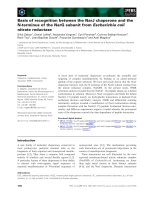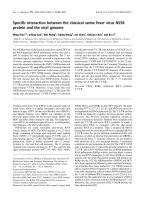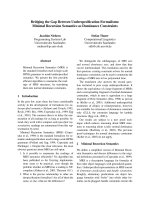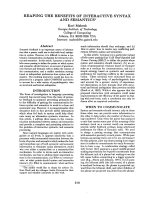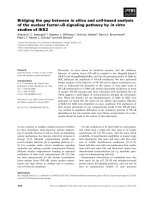Báo cáo khoa học: "Bridging the Gap between Dictionary and Thesaurus" pptx
Bạn đang xem bản rút gọn của tài liệu. Xem và tải ngay bản đầy đủ của tài liệu tại đây (284.88 KB, 3 trang )
Bridging the Gap between Dictionary and Thesaurus
Oi
Yee Kwong
Computer Laboratory, University of Cambridge
New Museums Site, Cambridge CB2 3QG, U.K.
Abstract
This paper presents an algorithm to integrate dif-
ferent lexical resources, through which we hope to
overcome the individual inadequacy of the resources,
and thus obtain some enriched lexical semantic in-
formation for applications such as word sense disam-
biguation. We used WordNet as a mediator between
a conventional dictionary and a thesaurus. Prelimi-
nary results support our hypothesised structural re-
lationship, which enables the integration, of the re-
sources. These results also suggest that we can com-
bine the resources to achieve an overall balanced de-
gree of sense discrimination.
1 Introduction
It is generally accepted that applications such as
word sense disambiguation (WSD), machine trans-
lation (MT) and information retrieval (IR), require
a wide range of resources to supply the necessary
lexical semantic information. For instance, Cal-
zolari (1988) proposed a lexical database in Italian
which has the features of both a dictionary and a
thesaurus; and Klavans and Tzoukermann (1995)
tried to build a fuller bilingual lexicon by enhancing
machine-readable dictionaries with large corpora.
Among the attempts to enrich lexical information,
many have been directed to the analysis of dictio-
nary definitions and the transformation of the im-
plicit information to explicit knowledge bases for
computational purposes (Amsler, 1981; Calzolari,
1984; Chodorow et al., 1985; Markowitz et al.,
1986; Klavans et al., 1990; Vossen and Copestake,
1993). Nonetheless, dictionaries are also infamous
of their non-standardised sense granularity, and the
taxonomies obtained from definitions are inevitably
ad hoc. It would therefore be a good idea if we can
unify our lexical semantic knowledge by some exist-
ing, and widely exploited, classifications such as the
system in Roget's Thesaurus (Roget, 1852), which
has remained intact for years and has been used in
WSD (Yarowsky, 1992).
While the objective is to integrate different lex-
ical resources, the problem is: how do we recon-
cile the rich but variable information in dictionary
1487
senses with the cruder but more stable taxonomies
like those in thesauri?
This work is intended to fill this gap. We use
WordNet as a mediator in the process. In the fol-
lowing, we will outline an algorithm to map word
senses in a dictionary to semantic classes in some
established classification scheme.
2 Inter-relatedness of the Resources
The three lexical resources used in this work are the
1987 revision of Roget's Thesaurus (ROGET) (Kirk-
patrick, 1987), the Longman Dictionary of Contem-
porary English (LDOCE) (Procter, 1978) and Word-
Net 1.5 (WN) (Miller et al., 1993). Figure 1 shows
how word senses are organised in them. As we have
mentioned, instead of directly mapping an LDOCE
definition to a ROGET class, we bridge the gap with
WN, as indicated by the arrows in the figure. Such
a route is made feasible by linking the structures in
common among the resources.
Words are organised in alphabetical order in
LDOCE, as in other conventional dictionaries. The
senses are listed after each entry, in the form of text
definitions. WN groups words into sets of synonyms
("synsets"), with an optional textual gloss. These
synsets form the nodes of a taxonomic hierarchy.
In ROGET, each semantic class comes with a num-
ber, under which words are first assorted by part of
speech and then grouped into paragraphs according
to the conveyed idea.
Let us refer to Figure 1 and start from word x2 in
WN synset X. Since words expressing every aspect
of an idea are grouped together in ROGET, we can
therefore expect to find not only words in synset X,
but also those in the coordinate WN synsets (i.e. M
and P, with words ml, m2, pl, P2, etc.) and the su-
perordinate WN synsets (i.e. C and A, with words
cl, c2, etc.) in the same ROGET paragraph. In
other words, the thesaurus class to which x2 belongs
should include roughly X U M U P U C U A. Mean-
while, the LDOCE definition corresponding to the
sense of synset X (denoted by D~) is expected to be
similar to the textual gloss of synset X (denoted by
GI(X)).
In addition, given that it is not unusual for
A
120. N. cl, c2, (in C); /~'" ~
ml, m2, (in M); pl, p2, B C
{el, c2, }.
GIfC)
(in P); xl, x2, (in X) I[
V
Adj E F M P X
[ml. m2 }.GI(M)
{pl, p2, I, GI(P}
{xl, x2, }, GI(X)
121.N
/~
R T
x2
I definition (Dx) similiar t,) GI(X)
or defined in terms of words in
X
t)r
C,
etc.
2
3
x3
I
2
(ROGEr)
0~VN)
(LDOCE)
Figure 1: Organisation of word senses in different resources
dictionary definitions to be phrased with synonyms
or superordinate terms, we would also expect to find
words from X and C, or even A, in the LDOCE def-
inition. That means we believe
Dx ~ GI(X)
and
D~N(XUCUA) 5¢.
3 The Algorithm
The possibility of using statistical methods to assign
ROGET category labels to dictionary definitions has
been suggested by Yarowsky (1992). Our algorithm
offers a systematic way of linking existing resources
by defining a mapping chain from LDOCE to RO-
GET through WN. It is based on shallow process-
ing within the resources themselves, exploiting their
inter-relatedness, and does not rely on extensive sta-
tistical data. It therefore has an advantage of being
immune to any change of sense discrimination with
time, since it only depends on the organisation but
not the individual entries of the resources. Given a
word with part of speech, W(p), the core steps are
as follows:
Step 1: From LDOCE, get the sense definitions
Dz, , Dt
under the entry
W(p).
Step 2: From WN, find all the synsets
Sn{wl,w2, }
such that
W(p) e Sn.
Also
collect the corresponding gloss definitions,
Gl(Sn),
if any, the hypernym synsets
Hyp(Sn),
and the coordinate synsets
Co(Sn).
Step 3: Compute a similarity score matrix .4 for
the LDOCE senses and the WN synsets. A
similarity score
.4(i,j)
is computed for the
i th
LDOCE sense and the
jth
WN synset using
a weighted sum of the overlaps between the
LDOCE sense and the WN synset, hypernyms,
and gloss respectively, that is
.4(i,j) = al[D, M Sj[ + a2IDi M gyp(Sj)[
+ asIni N GI(Sj) I
For our tests, we tried setting az = 3, a2 = 5
and as = 2 to reveal the relative significance of
finding a synonym, a hypernym, and any word
in the textual gloss respectively in the dictio-
nary definition.
Step 4: From ROGET, find all paragraphs
Pm{wi,w2,
} such that
W(p) E pro.
Step 5: Compute a similarity score matrix B for the
WN synsets and the ROGET classes. A simi-
larity score
B(j, k)
is computed for the
jth
WN
synset (taking the synset itself, the hypernyms,
and the coordinate terms) and the
k th
ROGET
class, according to the following:
B(j, k) = bllSj N Pkl + b2IHyp(Sj) M Pkl
+ bHCo(Sj) n Pkl
We have set bz = b2 = ba = 1. Since a ROGET
class contains words expressing every aspect of
the same idea, it should be equally likely to find
synonyms, hypernyms and coordinate terms in
common.
Step 6: For i = I to t (i.e. each LDOCE sense), find
max(A(i,j.))
from matrix A. Then trace from
matrix B the
jth
row and find
rnax(B(j,k)).
The
i th
LDOCE sense should finally be mapped
to the ROGET class to which Pk belongs.
We have made an operational assumption about
the analysis of definitions. We did not attempt to
parse definitions to identify genus terms but simply
approximated this by using the weights az, a2 and as
in Step 3. Considering that words are often defined
in terms of superordinates and slightly less often by
synonyms, we assign numerical weights in the order
a2 > az > as. We are also aware that definitions can
take other forms which may involve part-of relations,
membership, and so on, though we did not deal with
them in this study.
4 Testing and Results
The algorithm was tested on 12 nouns, listed in Ta-
ble 1 with the number of senses in the various lexical
resources.
The various types of possible mapping errors are
summarised in Table 2.
Incorrectly Mapped
and
Unmapped-a
are both "misses", whereas
Forced Er-
ror
and
Unmapped-b
are both "false alarms".
The performance of the three parts of mapping
is shown in Table 3. The "carry-over error" is only
1488
Word R W L Word R W L
Country 3 4 5 Matter 8 5 7
Water 9 8 8 System 6 8 5
School 3 6 7 Interest 14 8 6
Room 3 4 5 Voice 4 8 9
Money 1 3 2 State 7 5 6
Girl 4 5 5 Company 10 8 9
Table 1: The 12 nouns used in testing
Target Exists
Yes
No
Mapping Outcome
Wrong Match No Match
Incorrectly Mapped Unmapped-a
Forced Error Unmapped-b
Table 2: Different types of errors
applicable to the last stage, L -+R, and it refers to
cases where the final answer is wrong as a result of
a faulty outcome from the first stage (L +W).
L ~W W ~R L-~R
Accurately Mapped
68.9% 75.0% 55.4%
Incorrectly Mapped
12.2% 1.4% 4.1%
Unmapped-a
2.7% 6.9% 13.5%
Unmapped-b
13.5% 5.6% 16.2%
Forced Error
2.7% 11.1% -
Carry-over Error
- - 10.8%
Table 3: Performance of the algorithm
5 Discussion
Overall, the
Accurately Mapped
figures support our
hypothesis that conventional dictionaries and the-
sauri can be related through WordNet. Looking at
the unsuccessful cases, we see that there are rela-
tively more "false alarms" than "misses", showing
that errors mostly arise from the inadequacy of indi-
vidual resources because there are no targets rather
than from partial failures of the process. Moreover,
the number of "misses" can possibly be reduced if
more definition patterns are considered.
Clearly the successful mappings are influenced by
the fineness of the sense discrimination in the re-
sources. How finely they are distinguished can be
inferred from the similarity score matrices. Reading
the matrices row-wise shows how vaguely a certain
sense is defined, whereas reading them column-wise
reveals how polysemous a word is.
While the links resulting from the algorithm can
be right or wrong, there were some senses of the
test words which appeared in one resource but had
no counterpart in the others, i.e. they were not at-
tached to any links. Thus 18.9% of the LDOCE
senses, 11.1% of the WN synsets and 58.1% of
the ROGET classes were among these unattached
senses. Though this implies the insufficiency of us-
ing only one single resource in any application, it also
suggests there is additional information we can use
to overcome the inadequacy of individual resources.
For example, we may take the senses from one re-
source and complement them with the unattached
senses from the other two, thus resulting in a more
complete but not redundant sense discrimination.
6 Future Work
This study can be extended in at least two paths.
One is to focus on the generality of the algorithm by
testing it on a bigger variety of words, and the other
on its practical value by applying the resultant lexi-
cal information in some real applications and check-
ing the effect of using multiple resources. It is also
desirable to explore definition parsing to see if map-
ping results will be improved.
References
R. Amsler. 1981. A taxonomy for English nouns and
verbs. In
Proceedings of ACL '81,
pages 133-138.
N. Calzolari. 1984. Detecting patterns in a lexical data
base. In
Proceedings of COLING-8~,
pages 170-173.
N. Calzolari. 1988. The dictionary and the thesaurus
can be combined. In M.W. Evens, editor,
Relational
Models of the Lexicon: Representing Knowledge in Se-
mantic Networks.
Cambridge University Press.
M.S. Chodorow, R.J. Byrd, and G.E. Heidorn. 1985.
Extracting semantic hierarchies from a large on-line
dictionary. In
Proceedings of ACL '85,
pages 299-304.
B. Kirkpatrick. 1987.
Roger's Thesaurus of English
Words and Phrases.
Penguin Books.
J. Klavans and E. Tzoukermann. 1995. Combining cor-
pus and machine-readable dictionary data for building
bilingual lexicons.
Machine Translation,
10:185-218.
J. Klavans, M. Chodorow, and N. Wacholder. 1990.
From dictionary to knowledge base via taxonomy. In
Proceedings of the Sixth Conference of the University
of Waterloo,
Canada. Centre for the New Oxford En-
glish dictionary and Text Research: Electronic Text
Research.
J. Markowitz, T. Ahlswede, and M. Evens. 1986. Se-
mantically significant patterns in dictionary defini-
tions. In
Proceedings of ACL '86,
pages 112-119.
G.A. Miller, R. Beckwith, C. Fellbaum, D. Gross, and
K. Miller. 1993. Introduction to ~,VordNet: An on-
line lexical database.
Five Papers on WordNet.
P. Procter. 1978.
Longman Dictionary of Contemporary
English.
Longman Group Ltd.
P.M. Roget. 1852.
Roger's Thesaurus of English Words
and Phrases.
Penguin Books.
P. Vossen and A. Copestake. 1993. Untangling def-
inition structure into knowledge representation. In
T. Briscoe, A. Copestake, and V. de Paiva, editors,
In-
heritance, Defaults and the Lexicon.
Cambridge Uni-
versity Press.
D. Yarowsky. 1992. Word-sense disambiguation using
statistical models of Roget's categories trained on
large corpora. In
Proceedings of COLING-92,
pages
454-460, Nantes, France.
1489
